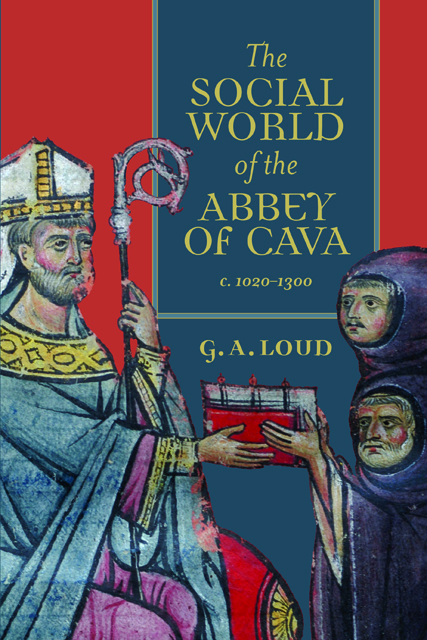Book contents
- Frontmatter
- Dedication
- Contents
- List of Maps and Charts
- Acknowledgements
- List of Abbreviations
- Note on the Organisation and Publication of the Cava Archive
- Dates
- Currency, Weights and Measures
- The Abbots of Cava, c. 1020-1300
- Maps
- I The Family of Vivus Vicecomes
- Introduction
- Part I The Abbey of Cava
- Part II Society and Economy
- Conclusions
- Appendix: Purchase and Expenditure by the Abbey of Cava, at Selected Periods between 1175 and 1230
- Bibliography
- Index
- Other volumes in Studies in the History of Medieval Religion
11 - The Monastery, the City and the Regional Economy
Published online by Cambridge University Press: 14 January 2023
- Frontmatter
- Dedication
- Contents
- List of Maps and Charts
- Acknowledgements
- List of Abbreviations
- Note on the Organisation and Publication of the Cava Archive
- Dates
- Currency, Weights and Measures
- The Abbots of Cava, c. 1020-1300
- Maps
- I The Family of Vivus Vicecomes
- Introduction
- Part I The Abbey of Cava
- Part II Society and Economy
- Conclusions
- Appendix: Purchase and Expenditure by the Abbey of Cava, at Selected Periods between 1175 and 1230
- Bibliography
- Index
- Other volumes in Studies in the History of Medieval Religion
Summary
The development and prosperity of the monastery of Cava were intimately linked with the city of Salerno, which lay only some 7 km from the monastery by the most direct route. The link between the two was already established under Abbot Leo, with the foundation of the monastery of St Nicholas de Palma in 1061/2. According to the Lives of the First Four Abbots, Leo was also in the habit of personally selling firewood in Salerno, the income from which he then used to buy bread for the poor, which charitable action in turn stimulated gifts to the monastery. Apart from this improving tale, we do have more prosaic documentary evidence showing that Leo and his successors were often present in Salerno, both to attend the princely, or later ducal, court and to supervise the urban property of the abbey. The latter grew, at first slowly and then substantially, until Cava must have been one of the largest landlords in the city. As a result Cava drew a not inconsiderable income from this property portfolio, and from various specialist enterprises in and near the city. But the city of Salerno was also important to Cava as a market and a port, through which the monastery was tied into the wider regional economy. The full details of this latter process are by no means easy to discern from the extant sources, but certain indications suggest how and why the prosperity of the monastery was intimately connected to the urban economy of Salerno.
Urban Property
We have no evidence for Cava possessing property in Salerno before the foundation of the monastery of St Nicholas, which as we have seen was a joint endeavour between Abbot Leo and Vivus vicecomes in the early 1060s. But from soon after that foundation the abbey started to acquire other property in the city. Already by February 1070 the monastery of St Nicholas possessed a stone-built two-storey house with a cellar and oven, the solar of which was then, in the presence of Abbot Leo, leased to a tenant, for his lifetime. He was to render to the monastery half the fees from the oven, and thus would appear to have been the baker who operated it.
- Type
- Chapter
- Information
- The Social World of the Abbey of Cava, c. 1020-1300 , pp. 341 - 384Publisher: Boydell & BrewerPrint publication year: 2021



